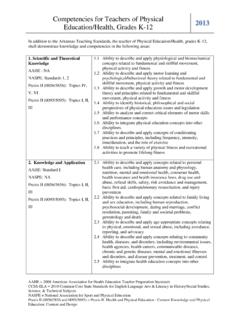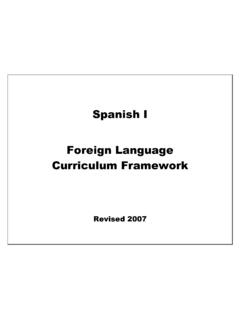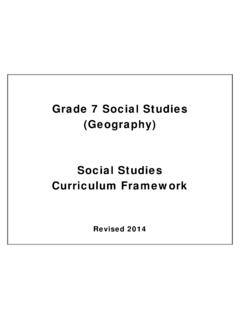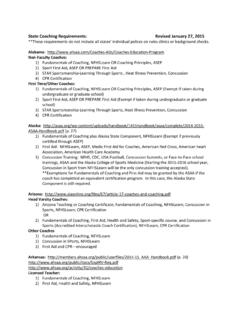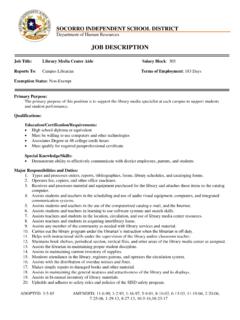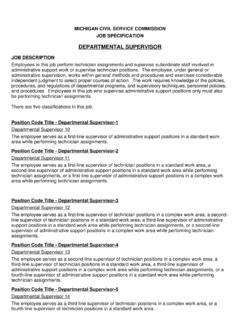Transcription of Title I - Arkansas Department of Education
1 1 - Arkansas Comprehensive School Improvement Planning (ACSIP) Handbook 2011-2012 (Revised May, 2011) Arkansas Department of Education Dr. Tom Kimbrell Four State Capitol Mall Little Rock, Arkansas 72201 2 Introduction The Arkansas Comprehensive School Improvement Planning (ACSIP) model is an annual planning and fund distribution design that must be used by all Arkansas public and charter schools, as defined by Ark. Code Ann. 6-15-419. Using the ACSIP model, each school in Arkansas develops a comprehensive school improvement plan. The plan is also used as the school s application for all federal programs administered by the Arkansas Department of Education , under Elementary and Secondary Education Act (ESEA), in addition to Student Special Use Funds.
2 It must include activities based on the school s greatest needs and identify the performance of student subgroups if the subgroup did not meet the achievement level necessary for Adequate Yearly Progress (ADE Comprehensive State Application Accountability Plan, 2004). To prepare school improvement plans and application materials for the ADE each fiscal year, schools and districts must gain access to the latest version of the ACSIP web-based program. For information regarding the ACSIP software or ACSIP process, contact the School Improvement Unit, Room 301B, Four State Capitol Mall, Little Rock, Arkansas 72201; Telephone 501-683-3434, or visit our website at It is important to note that the ACSIP Handbook is a tool designed to assist in the creation and publication of each district and school s ACSIP plan.
3 In addition, school planners must have a collective understanding of the ACSIP process, state and federal laws and regulations and the requirements for the use of state and federal funds. This handbook contains information that may assist readers and stakeholders (educators, administrators, federal programs coordinators, accounting officials, parents and persons interested in successful schools) concerning these topics. The technical assistance documents in the handbook are based on Department of Education (USDOE) policy guidance materials, ESEA, Arkansas law and ADE Commissioner s Communication. The particular sections of the ESEA legislation are referenced in the Title of each document.
4 The ESEA legislation and the ESEA regulations are available on the USDOE website at 3 Arkansas COMPREHENSIVE SCHOOL IMPROVEMENT PLANNING (ACSIP) HANDBOOK TABLE OF CONTENTS Glossary 4 ACSIP requirements 10 District Web requirements 14 Title I-A Improving Academic Achievement of Disadvantaged Children 15 School Improvement 16 District Improvement 22 Smart Accountability 23 Title II-A Teacher and Principal Training and Recruitment 26 Title II-D Enhancing Education through
5 Technology 29 Title III Language Instruction for Limited English Proficient and Immigrant 31 Students Title IV-A Safe and Drug-Free Schools and Communities Act 34 Title VI Federal and State 37 Transferability of Funds 38 Budgeting Federal Funds in ACSIP 39 General Budgeting, Funding and Accounting Principles for Federal Funds Accounting 45 Paraprofessionals 51 Highly Qualified Teachers 52 Professional Development for Schools in School Improvement 55 Professional Development 56 Homeless Children 59 Neglected Institutions 59 Delinquent Institutions 60 Parental Involvement 61 Private School Children 68 School-wide Program 76 Targeted Assistance Program 77 Preschool 80 Student Special Needs Funds
6 82 Complaint Resolutions 88 References 96 Appendixes Appendix A: Checklist for HQT Designation 97 Appendix B: ARHOUSSE Survey 99 Appendix C: Sample Parent Right to Know Letter 101 Appendix D: Highly Qualified Teacher School Form 102 Appendix E: District Wide Parental Involvement Policy 103 Appendix F: School-Parent Compact 107 Appendix G: Sample Parent Notification Letters for Schools in Improvement 112 Appendix H: Consultation Form 122 4 Appendix I: Student Eligibility List 123 Appendix J: Calculating Private School Set Asides 124 Appendix K: Statewide System of Support Overview 125 Appendix L.
7 Scholastic Audit 126 Glossary Adequate Yearly Progress (AYP) AYP is a measure used to ensure the same high standards of academic achievement apply to all public elementary and secondary schools and students in the state, not just Title I schools and Title I students. The measure must be statistically valid and reliable and result in continuous and substantial academic improvement for all students. The state plan must define the following elements: Primary assessments Other academic indicators Process of establishing AYP Adjustment An adjustment to a budget Will move money around within the approved budget categories, however, it will not change the total amount of money budgeted; and Does not add a new staff position, a new budget function code (Line item), budget object or change capital outlay.
8 (Adjustments have a May 2 deadline.) Alignment Evidence that local curriculum, assessments and instruction provided by highly qualified teachers, highly qualified paraprofessionals and professional development are in line horizontally and vertically with Arkansas Frameworks and state assessments and actions are included to show evidence of continual review and updating. Amendments An amendment to a budget will do one, or more, of the following: Increase or decrease the total amount budgeted; Adds a budget function code (line item) or budget object code; Add staff; or Increase the amount budgeted for capital outlay. (Amendments have a May 2 deadline.)
9 AR HOUSSE Point-scale criteria by which a teacher can demonstrate content area competency by compiling points for activities conducted or performed that are directly related to the content area the teacher teaches. 5 Body Mass Index (BMI) A popular method used to gauge whether or not a person is overweight. BMI is calculated by dividing a person s weight (in kilograms) by his or her height (in meters, squared). Choice Transportation In the case of a school identified for school improvement, the school district will, no later than the first day of the school year following identification, provide students enrolled in the school with the option to transfer to another public school served by the school district, which may be a public charter school, that has not been identified for school improvement, unless this option is prohibited by State law.
10 In accordance with ESEA, the option to transfer to another school must be given to the lowest-achieving children from low-income families. Comparability A district must meet the comparability requirement as follows: A district may receive Title I, Part A funds only if it uses state and local funds to provide services in Title I, Part A schools that are at least comparable to the services provided in schools that are not receiving Title I, Part A funds. If all schools in a grade span are Title I schools, 110% of the average for the schools with the lowest low-income percent is compared to the schools with the highest low-income percent. Comparability reports are required for districts having more than one school per grade level.


